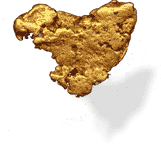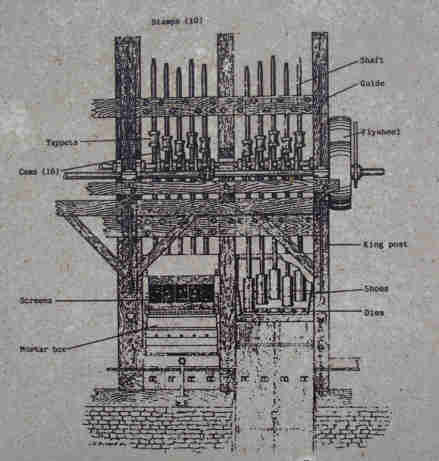


|


Lady Alice Gold Mine |
 |
Regardless of the low yields, and the many rumours, Miss Nicholls, sister in law of Captain Clarke, in the presence of several parliamentarians, started the long awaited new ten-head crusher. Shareholders were told that although the mine had its difficulties, the lode had been found again and prospects had never looked brighter. At the first crushing, the results of eight days work, more than 70 ounces of gold and three tons of copper were obtained. This was followed by another 105 ounces from 325 tons during the first two weeks of December. During that time a tailings pump had also been installed to remove the sand and slurry from the battery.
With the miners increasingly gaining more confidence in the permanency of the mine and their jobs, it was decided to have the first cricket match of the season played between the married and single men of Humbug Scrub. The single men won with William Lloyd scoring 15 runs. At the Lady Alice the amount of gold obtained after each crushing remained low. While some men were stoping new areas, others were set to work on the dam, cleaning up underground and general maintenance. By October the yield began to increase again and in December it was confidently stated the mine would return a profit of 6,000 per annum. The first crushing in 1876 yielded 104 ounces of gold and three tons of copper.
Unfortunately the Balance sheet of 21 February 1876 showed a balance of over 1,000 on the wrong side of the ledger after allowing for the recently paid dividends. Despite all the boosting of the Lady Alice directors, production declined sharply once again. In April 1876, after another call of one shilling, and with a further three due before August, investors wanted to know what was going to be done with the mine when only 16 ounces of gold and one ton of copper were recovered.
 |
Drawing of a ten-head crusher
Directors were blamed for not planning ahead, paying too many dividends, and generally spending their money too fast. Captain William Clarke, who also disagreed with the directors, resigned but was presented with a gold chain and medal by the miners anyway. His men had been unanimous that he should not leave without receiving a token of their esteem and respect. The medal was suitably inscribed with Presented to Captain William Clarke, by the workmen of the Lady Alice Mine, as a token of their respect, 28 June 1876.
It was now seriously suggested to give old Goddard another chance to pull the mine up again to a paying condition. After all, people in Adelaide had faith in him. However Goddard was occupied with more important matters. He had just become director of the Uraparinga Copper mine near Williamstown which was renamed the Wheal Friendship.
At the general meeting of the Lady Alice Company it was revealed that the sale of gold during the last six months had given a return of 1,978 and for copper 1,125. Although this was certainly good news for the shareholders, a lot more money was needed to keep both the mine and further prospecting going. A month later it was decided to increase the companys capital not only by making additional calls on the long suffering shareholders, but by issuing an additional 12,000 shares of 1 each. One shilling was to be paid on allotment and the balance by calls as and when required. Most of the shareholders seemed to be pleased with this idea and many invested in additional shares.
 |
A ten-head crusher on display at Pine Creek (NT)
As a result of increasing the stoping areas, some good yields were obtained at times between April and July. In May, when crushings had yielded 401 ounces of gold and 11 tons of copper, the company advertised for additional miners. In June it also wanted a competent Mine Manager, who understood the dressing and manipulation of gold and copper. Towards the end of the year everything was working once more according to expectations but after the mine had reached a depth of 200 feet yields once more declined. The managers report of November stated that 320 tons had been crushed yielding only 14 ounces, which was a great disillusionment for everyone concerned.
In 1877 the Lady Alice Company advertised for a new manager and made several calls on its shareholders for additional funds. On 29 January as many as 164 tons of ore were crushed, but they only gave 19 ounces of gold. The managers report of 5 April stated that in consequence of the late heavy rains only 150 tons had been crushed, yielding 21 ounces of gold and two tons of copper. A crushing of 154 tons in May gave 31 ounces of gold.
After the appointment of a new captain, the mine was cleaned up thoroughly and in July worked the battery for fully sixteen hours a day crushing 150 tons of stone which yielded 30 ounces of gold and two tons of copper. Several drives at the different levels had been extended and it was said that prospects were looking better all the time. Sleepers had been laid for an underground tramway and aboveground several men were constructing a poppet head, pithead pulleys and an engine and winding gear.
During the next few weeks it had been necessary to timber the stopes at the 50 feet level which turned out to be labour intensive and thus expensive. They still managed to obtain gold and over a ton of fine copper but the crushers were only worked for nine hours a day. As a result of all these additional costs for labour, material, machinery and general development of the mine, which could take weeks or months, it was very difficult at times to make the mine pay its way.
A lot more gold, or copper, would have to be produced on a regular basis to avoid making more calls for additional shareholders money. After all, failing to pay miners, staff or suppliers would result in premature closure of operations. Even today it can take several years of planning, feasibility studies, underground development, building of the infra structure, including facilities for employees and their families, before mining can even start.
 |
Lady Alice Mine, 1893. (Allan Clarke)
There was even less excitement at the office of the Lady Alice. Secretary WR Lewis declared as many as 275 shares forfeited for non-payment of calls and at the same time made a new call of one shilling on the second issue of new shares numbered 12,001 to 24,000. At the mine the news was a little better.
By the end of August the tramway from the shaft to the battery had been completed and pipes had been laid from the battery to the dam to return the water used in the crushing process. All other machinery was working and in good condition resulting in some good yields of both gold and copper. Fortnightly crushings during September, October and November produced 20 ounces on average. The December crushings increased to 100 ounces. Despite these excellent results, most miners were discharged just before the Christmas holidays.
At the end of the year more surface work was undertaken and the installation of the engine, boiler and flue completed. Once more directors decided to repeat the previous successful arrangement of running the mine on tribute. An agreement was made with Captain Clarke, who supervised 18 men to work the mine on tribute. Clarke was to receive 15 per cent tribute for the first three months and 25 per cent during the following three months with a right to retain that for two years.
It seemed a good proposition as the mine had substantial engines and machinery in place. There was a pumping and crushing engine of 25 horsepower and a working crusher. Unfortunately neither Clarke nor the next captain, James Nicholson Thomas, who had just arrived from Redruth in Cornwall, could make the mine pay and both pulled out even before the three months had expired. Worse was to come.
In July 1878, WR Lewis reported the mine flooded when the nearby dam broke its bank during a heavy downpour. The men working underground only just managed to get up in time but had to leave all equipment and their tools behind. Dewatering the mine would be a costly and time consuming affair.
After all these setbacks, low yields and constant need for more money, the directors decided to call an extraordinary general shareholders meeting for 12 August 1878 at the Gawler Institute to consider the advisability of winding up the company and appointing liquidators. The mine, which had used up 45,000 of shareholders money, had only paid dividends of 3,800. The total amount of gold produced during these years was 5,816 ounces, valued at 19,000.
In January 1879 Secretary Lewis informed creditors of the company to send him their names and nature of debts to be included in the benefits of any distribution of the companys assets. A final shareholders meeting was held on 14 March to make it possible for them to view the accounts of the winding up.
 |
One Happy Family at Humbug Scrub, 1893. (Allan Clarke)
Augustus Carwithen on right, Eleanor and James Goddard sitting on left in middle row.
The closing of the mine and sale of its machinery came as a shock. Several people were prepared to spend still more money hoping that like the Phoenix, a new Lady Alice Mining Company would rise from the ashes. Unfortunately it took nearly three years for this to eventuate. Meanwhile some further work was carried out at the mine and by the end of 1879 the total value of gold produced since it was started amounted to 25,000 and copper to the value of 4,000.
The Lady Alice Gold Mining Companys lease 41, on section 309, was cancelled on 27 April 1886. It seemed to be the end of the one goldmine that had not only brought excitement, both in the Barossa and elsewhere, but also had yielded large amounts of gold and several dividends. Many people had called it the richest mine ever opened in South Australia and were convinced that it would not be long before another company would reopen this mine.
please go to home page for more information.
Thank you for visiting South Australian History,
We hope you enjoy your stay and find the information useful.
This site has been designed and is maintained by FRR.

